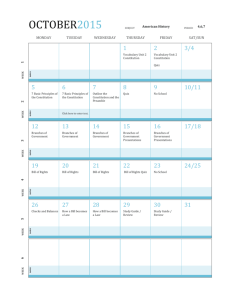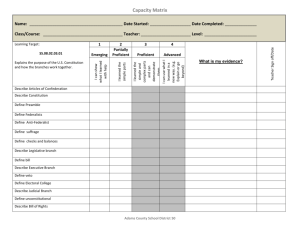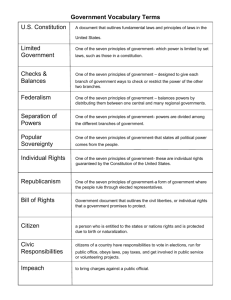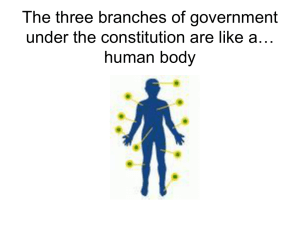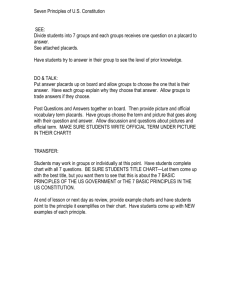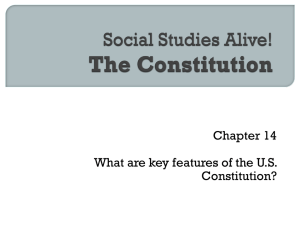Lesson Plan 3- Branches of Government
advertisement
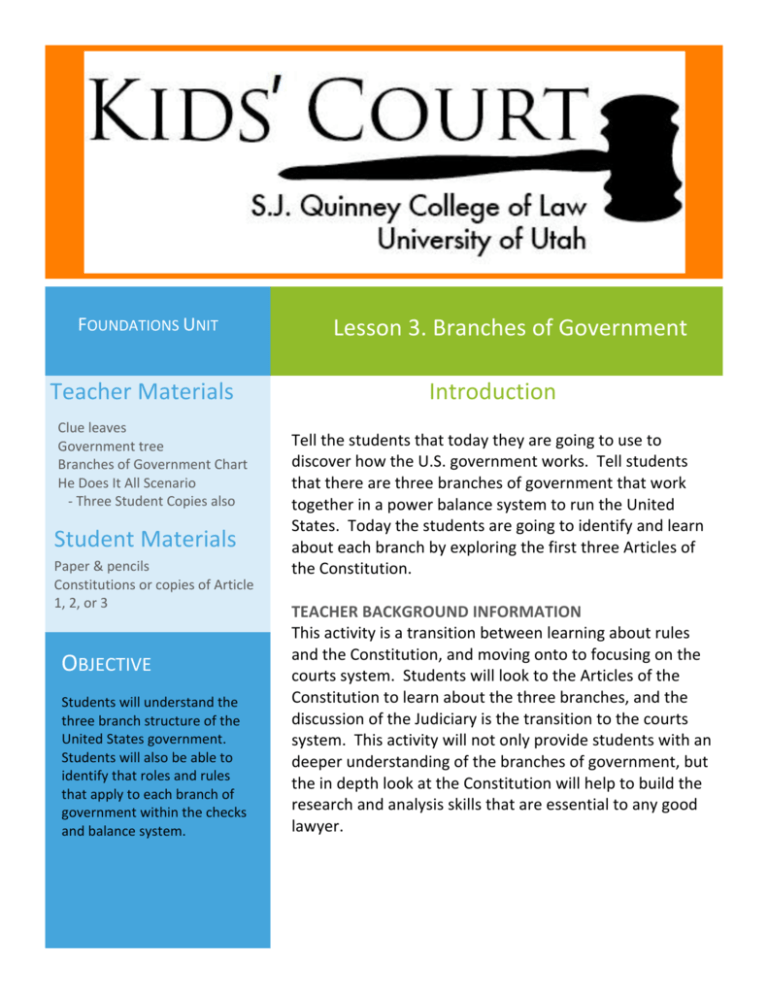
FOUNDATIONS UNIT Teacher Materials Clue leaves Government tree Branches of Government Chart He Does It All Scenario -­‐ Three Student Copies also Student Materials Paper & pencils Constitutions or copies of Article 1, 2, or 3 OBJECTIVE Students will understand the three branch structure of the United States government. Students will also be able to identify that roles and rules that apply to each branch of government within the checks and balance system. Lesson 3. Branches of Government Introduction Tell the students that today they are going to use to discover how the U.S. government works. Tell students that there are three branches of government that work together in a power balance system to run the United States. Today the students are going to identify and learn about each branch by exploring the first three Articles of the Constitution. TEACHER BACKGROUND INFORMATION This activity is a transition between learning about rules and the Constitution, and moving onto to focusing on the courts system. Students will look to the Articles of the Constitution to learn about the three branches, and the discussion of the Judiciary is the transition to the courts system. This activity will not only provide students with an deeper understanding of the branches of government, but the in depth look at the Constitution will help to build the research and analysis skills that are essential to any good lawyer. FOUNDATIONS UNIT Adaptation/ Differentiation For a more formal evaluation or for a challenge print off blank copies of the Branches of Government Chart and have the students try to fill them out while other groups are presenting the facts. Also instead playing the Branches of Government Game as a class, make trees and leaf decks smaller and have students attempt to complete them individually. To extend this lesson, think about running a much larger simulation based of the He Does It All Scenario. Involving more students and making the scenario longer could really give the students a sense of the importance of checks and balances. Lesson 1. The Importance of Rules in Our Country and in Our Classroom Activity: 1.5-­‐2 Hours Pass out mini Constitutions and/or copies of the first three Articles of the Constitution to students. Then break the students into three groups. Assign each group to Article 1, Article 2, or Article 3. Give each group pencil and papers, and tell them that it is their job to go through their Article, identify which branch of government their Article describes, and write down as many facts about that branch as they can in 15-­‐30 minutes. The facts must not be directly copied from the Constitution, the students must be able to explain the facts they pick out in their own words. At the end of the time, each group should present their facts to the rest of the class; the group with the most accurate facts wins. While the students are presenting these facts, recreate the “Branches of Government Chart” on the board, and fill out each section as the facts come up. If the facts required to complete the chart don’t come up during the presentations, have the students help you to figure out what should go into the chart. Follow up by selecting three students (narrator, police officer, and the student) to act out the scenario in “He Does It All”. Use this role play to lead the children in a discussion of checks and balances. There are several discussion points noted at the bottom of “He Does It All”. CORE CURRICULUM STANDARD: 5 TH GRADE SOCIAL STUDIES STANDARD 3.1.C, 3.1.E & 3.2.A Standard 3: Students will understand the rights and responsibilities guaranteed in the United States Constitution and Bill of Rights. Objective 1: Assess the underlying principles of the US Constitution. c. Distinguish between the role of the Legislative, Executive and Judicial branches of the government. e. Describe the concept of check and balances. Objective 2: Assess how the US Constitution has been amended and interpreted over time, and the impact these amendments have had on the rights and responsibilities of citizens of the United States. a. Explain the significance of the Bill of Rights. 2 FOUNDATIONS UNIT Assessment Branches of Government Game-­‐ Create a deck of leaves (colorful index cards cut into the shape of leaves), and a large government tree that can be posted on. Each leaf should have one fact about one the three branches of government. The government tree should have three major branches coming out of the trunk. One of the major branches should be labeled “Executive”, one should be labeled “Legislative” and the third should be labeled “Judicial”. Pick a student volunteer to come up and read a clue leaf. After the student reads the clue aloud, have them try to place it on the tree in the correct branch of government. If the student struggles allow for help from the other kids. Repeat this process until each student gets a turn, or all the clue leaves are properly placed. Lesson 1. The Importance of Rules in Our Country and in Our Classroom Closure Use the completed government tree to reinforce the concept of checks and balances, through an analogy of the tree as an ecosystem that would be threatened if one branch became too weak, or if another branch grew too strong. The government, like the tree, also needs to maintain a delicate balance between the branches, or it will be at risk. Finish off this lesson by asking the students to guess which branch of Government we are going to focus on for the majority of Kids’ Court. Answer: Judiciary! Tell students that for the next few lessons we are going to be focusing on different aspects of the Judiciary branch. TEACHER TIP! Encourage student participation in role-plays with a lot of praise: “You make that look easy!” “I’m very proud of you.” “Fantastic job!” 3 FOUNDATIONS UNIT Lesson 1. The Importance of Rules in Our Country and in Our Classroom Brain Break! Kids seem a bit antsy? Have they been sitting for more than 15-­‐20 minutes? Give their brain, and yours, a break with one of these activities. Afterward, they’ll be more focused on the next activity. FREEZE DANCE Pick a song that somehow relates to something you’ve been discussing with your class. Explain or have the children guess at what the significance of the song may be. Then have the kids get up and find some personal space. Have the participants get up and start to dance, if they are reluctant to dance, call out the following actions/dance moves for them to do: -­‐High knees -­‐Macarena -­‐Slide side to side -­‐Twinkle toes -­‐The twist -­‐Raise the roof -­‐Hop on one leg -­‐Walk like an Egyptian Pause the song at random, when the music stops the kids must stop moving immediately. Whoever moves should be disqualified and have to sit down. At the end of the song whoever is left standing wins! BRAIN TEASERS (REBUS PUZZLES) These are essentially little pictures, often made with letters and words, which cryptically represent a word, phrase, or saying. These require logically thinking and critical evaluation by the students, they work well to give them a sense of how lawyers think as problem solvers. Brainteasers also work well as a fun bonus activity when students finish their assignments early. Rewarding the students who get the most correct with a prize can encourage the students to work more effectively and efficiently. This website: http://www.fun-­‐with-­‐ words.com/rebus_puzzle_expla in.html gives examples of the puzzles and explanations on how to solve them. This website: http://www.fun-­‐with-­‐ words.com/rebus_puzzles_01.h tml has 100 different puzzles. BONUS QUESTIONS While executing lesson plans questions frequently arise. Sometimes these questions may come from a teacher, or from a student in the class. Whenever the question is interesting and pertinent to the subject matter, and the answer is not generally known by the participants try turning the question into a bonus question. Tell the students to go home and research the answer, write the answer on a piece of paper, and bring it back to the next class session. Depending upon your resources, every student who returns with a correct answer may get a prize, or place names of all of the students who gave the correct answer into a hat, and pull one out then reward that particular student with a prize. Example 1: (During a lesson on the Constitution) “Which was the first state to ratify the Constitution?” Example 2: (During a lesson on Civic Participation) “What year did women gain the right to vote?” 4 FOUNDATIONS UNIT Lesson 1. The Importance of Rules in Our Country and in Our Classroom HE DOES IT ALL! Narrator: It’s a beautiful April afternoon. Karla just arrived home from school. Even before she gets through the front door, her mother meets her with an armload of books. “Take these books back to the library, would you please? We’ve got to get them back today, or they’ll be overdue.” She then added the magic words, “Take the car, if you wish.” Hey, that’s all right! Karla just got her driver’s license. Off she goes. When she come back to the car after dropping the books in the book drop, a police officer is standing by her car. Good grief, what could be wrong? He hands Karla a ticket! (With her new driver’s license, she had been really careful. She was in a parallel parking place, just the right distance from the curb, and she had checked carefully for “No Parking” signs.) Karla: What did I do wrong, Officer? Officer: You can’t park here. Karla: But there isn’t a “No Parking” sign. Officer: I just made it no parking. Karla: But you can’t do that! Officer: I can now. You’re under arrest. Karla: Arrest? How can I be under arrest when I didn’t break a law? Officer: You did break a law, my law. You are under arrest. Karla: What happens now? Officer: I try you. Karla: Try me! You’re not a judge! Officer: I am now. You’re guilty. I fine you $25 and costs. Karla: Twenty-­‐five dollars and costs! How much are the costs? Officer: Another $25. Karla: But I’m not guilty! Officer: Pay me. 1. This make-­‐believe officer did it all! What did he do? A. B. C. 2. Would this happen in the United States? Explain: 3. What might happen if one branch had too much power? 4. The system is called checks and balances, based on the facts we have learned so far can anyone give an example of something one branch is able to do, but not another branch? 5 FOUNDATIONS UNIT Lesson 1. The Importance of Rules in Our Country and in Our Classroom Simple Branches of Government Chart Branch Who Works There? Executive Senators in the Senate Representatives in the House of Representatives What Do They Do? Make, change and repeal laws. The Senate and the House of Representatives make up Congress Legislative President Vice President Cabinet members Carry out laws. The federal agencies and departments make federal regulations and see that laws are enforced. People who work in the Departments and Agencies Carry out laws. Judicial Supreme Court Justices Interpret and define what laws mean in specific cases. Determine if any laws go against the Constitution. Federal judges 6
